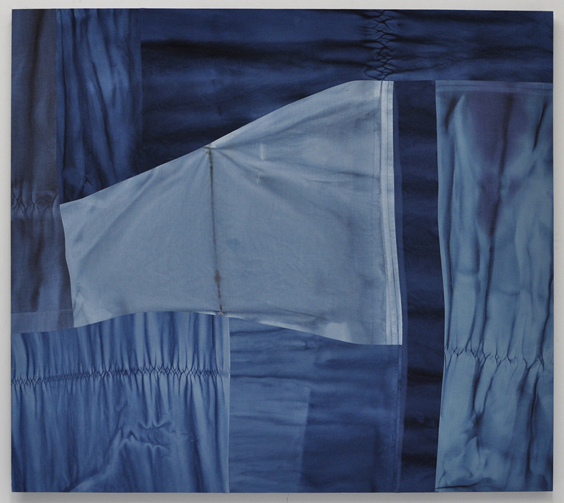
Colleen Heslin, Blue Monochrome, 2014. Ink and dye on cotton. 48 x 54 inch. Courtesy the artist and Galerie Laroche / Joncas, Montréal
COLLEEN HESLIN
BALLADS FROM THE NORTH SEA
Galerie Laroche/Joncas, Montréal
8 March to 26 April, 2014
Review by Joseph Henry
On the crowded fourth-floor of the Whitney Biennial, a floor curated this year by Stuart Comer, American artist Ken Okiishi brought painting into contact with the galleries’ propensity toward new and electronic media. For his contribution to the Biennial, a major exhibition designed to showcase recent American art, Okiishi painted over consumer-grade television monitors, obscuring their moving images with messy acrylic. If perhaps blunt in its multimedial comparison, Okiishi’s work symbolized a relatively new place for painting after its perennially announced death by Paul Delaroche in 1839, and countless others since. In a digital visual culture dominated by screen technologies and their perceptual flatness, painting has been revived as a key medium in the investigation of the surfaces and places from which images are produced and consumed.
Canadian painters have jumped on this opening as well, from Scott Everingham’s chromatic gradients and David Elliot’s Google Image-Wunderkammer to even Pierre Dorion’s recent photographic schematics. Yet, in a kind of parallax formation, recent RBC Canadian Painting Competition winner Colleen Heslin has used the traditional tenants of painting (dimensionality, planarity, mark-making) in tandem with actual fabric and dye on canvas to disassemble the cool construction of the image as we take it for granted in art history as much as media culture. Heslin’s work appears as painting-after-the-fact, returning to a deconstruction of flatness, surface, and the hand after Greenberg. It harkens to modernism in its formal attention, but also to questions of medium that have largely been neglected in contemporary practice. It’s no surprise then, that Heslin named her newest presentation “Ballads from the North Sea”, on display at Montreal’s Galerie Laroche/Joncas, after an influential 1999 essay by prominent postwar art historian Rosalind Krauss. Backed by the pillars of art theory and history, Heslin’s show at Laroche/Joncas argued for the possible medium-specific ability of painting to recalibrate visual experience, even if some of her works executed this notion better than others. It’s a risky ploy to advocate for a medium long considered obsolete, or at times apolitically decorative, and while Heslin’s decidedly local scope can feel hermetic, it also inspires a strong need to reconsider painting’s former perdition and current signification.
While Krauss’s essay “A Voyage on the North Sea: Art in the Age of the Post-Medium Condition” serves as the ambitious, if predictable point of inspiration for Heslin, the more intriguing reference in Krauss’s text is Walter Benjamin. For the German critic, a technological mode sees its highest potential at its immediate birth and its eventual obsolescence – events from which it can escape immediate use-value. Painting uneasily occupies that middle ground: while the analog surface has taken a backseat in digital visual culture, painting moves just as strongly in the artworld for its exchange value and historical ubiquity.
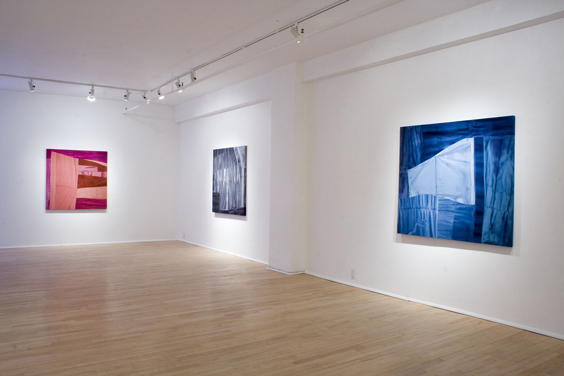
Exhibition View, Colleen Heslin, Ballads From The North Sea, 2014. Courtesy the artist and Galerie Laroche/Joncas, Montréal
Heslin’s strength in making her dyed fabric on canvas seems like a critique of the digital surface, in a Benjaminian circle. The labour of stitching together compositions becomes Heslin’s questioning of craft, work, and surface. Her compositions are most compelling when the artist’s aesthetic intentionality is under scrutiny. A pink monochrome appears fussy in its vertical symmetry, while the exhibition’s most beguiling entry, a blue composition, plays with randomness and choice in its rhythmic structure, although this literality sometimes goes too far, as in one purple work that appears to needlessly cover the whole canvas. Heslin seems to toy with the artist’s hand, “painting” by collage but skillfully refusing her work’s status as collage.
In discomfiting the construction of the surface image in geometrically focused monochromes, Heslin circles back to painting as a rejoinder to the slick planarity of the digital, à la Benjamin’s temporal loop. Physical mark-making no longer constitutes the primer of our cultural imagery, but here Heslin unpacks the hidden inner-workings from the confinement of so-called new media. For Krauss, any medium is an aggregate, an additive constellation of its conditions of possibility, beyond its sheer materiality. Heslin works off that sentiment: the aesthetic articulation of a surface surprisingly promising depth. Whereas the digital image relies on the obviation of that fact, Heslin puts the labour and craft of that construction upfront.
It’s an ambitious project, on par with Krauss’s famously difficult theory, and Heslin only delivered the morphological goods on a few canvases with the right balance of movement, form, and relation. When facing paintings that “work,” these appear to almost burst at the seam in their tension between process and result. If the idea of “flatness” served as the underlying pivot between modernism and postmodernism, as art historian David Joselit suggested in his 2000 essay “Notes on Surface – Toward a Genealogy of Flatness”, then Heslin’s post-postmodernist deconstruction of the surface argues for an art history not so neatly bifurcated by Greenberg’s proponents or detractors. In our everyday visual field, flatness has returned as a primary phenomenological condition, and painterly work like Heslin’s seems suitably poised to break open the quasi-banality of the digital flat screen.
Joseph Henry is a PhD student in Art History at the CUNY Graduate Center.
Galerie Laroche/Joncas
#410, 372 Ste-Catherine O.
Montréal, Qc H3B 1A2
Canada
www.larochejoncas.com
Opening hours
Wednesday – Friday: 11h00 – 18h00
Saturday: 12h00 – 17h00
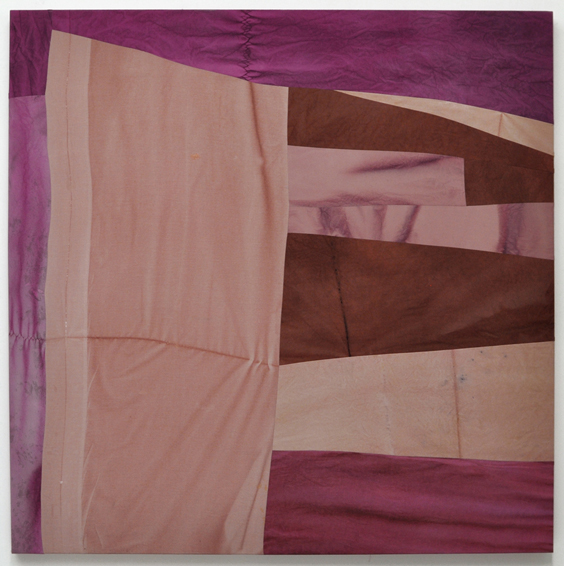
Colleen Heslin, Pink Monochrome, 2014. Dye on cotton. 48 x 48 inch. Courtesy the artist and Galerie Laroche / Joncas, Montréal
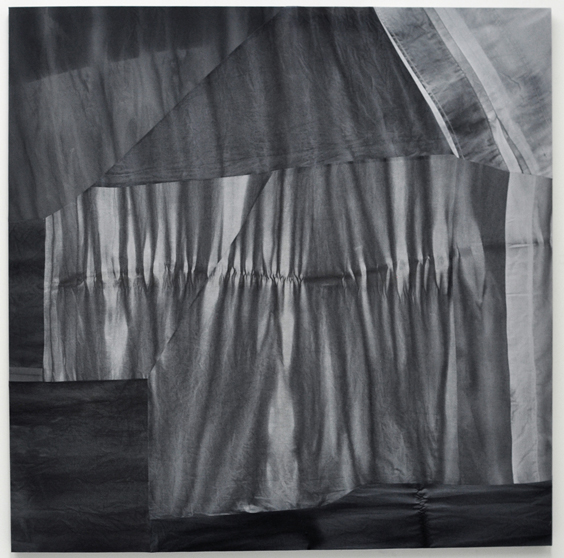
Colleen Heslin, Grey Monochrome, 2014. Ink and dye on cotton. 48 x 48 inch. Courtesy the artist and Galerie Laroche / Joncas, Montréal
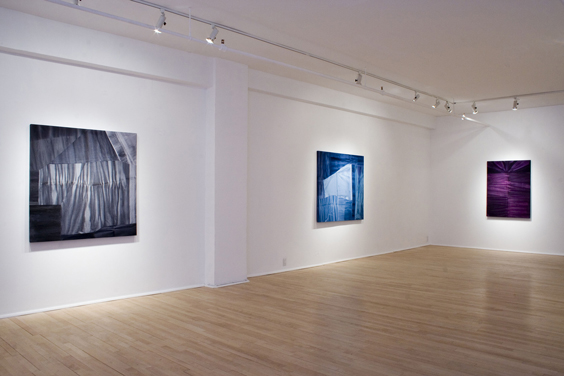
Exhibition View, Colleen Heslin, Ballads From The North Sea, 2014. Courtesy the artist and Galerie Laroche/Joncas, Montréal
